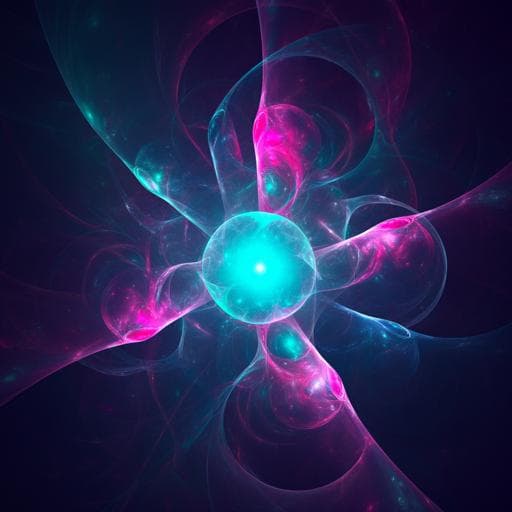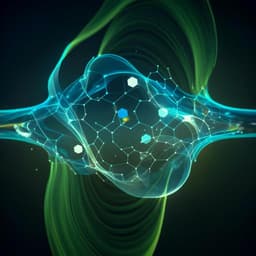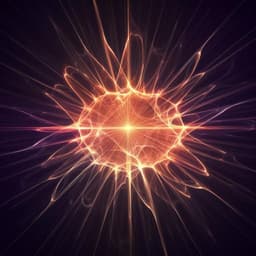
Physics
Observation of flat band, Dirac nodal lines and topological surface states in Kagome superconductor CsTi₃Bi₅
J. Yang, X. Yi, et al.
Kagome lattices of transition metals reveal remarkable phenomena such as the anomalous Hall effect and quantum spin liquids. This research by Jiangang Yang and colleagues uncovers a flat band in the novel kagome superconductor CsTi₃Bi₅, showcasing Dirac nodal lines and intriguing topological surface states formed by spin-orbit coupling.
~3 min • Beginner • English
Introduction
Layered kagome materials host a two-dimensional network of corner-sharing triangles whose electronic structure features flat bands, Dirac cones and saddle points, enabling exotic phases such as spin liquids, topological states, anomalous Hall effect and unconventional density waves. Despite extensive study of AV₃Sb₅ (A = K, Rb, Cs), definitive spectroscopic identification of these hallmark kagome electronic features and their connection to emergent phenomena remains incomplete and debated. CsTi₃Bi₅ is isostructural to AV₃Sb₅ but shows no charge-density-wave transition, offering a clean platform to probe the intrinsic kagome electronic structure. This study aims to determine the low-energy band structure of CsTi₃Bi₅ using high-resolution laser ARPES and DFT, to directly observe the kagome-derived flat band, map Dirac nodal loops/lines, and identify Z₂ topological surface states, and to compare with AV₃Sb₅ to elucidate structure-property relations in kagome systems.
Literature Review
Prior theoretical and experimental works predict and in some cases observe flat bands, Dirac cones and van Hove singularities in kagome systems, underpinning phenomena including topological insulating/semimetal phases, spin liquids, fractional and anomalous Hall effects, and unconventional density waves and superconductivity. The AV₃Sb₅ family exhibits anomalous Hall effect, unconventional CDW, possible pairing density waves and nematicity, yet the microscopic origin remains debated. ARPES reports of flat bands exist in kagome metals such as GdVSn, YMnSn, CoSn, Fe₃Sn₂ and FeSn, but clear ARPES evidence of kagome-derived flat bands in the 135 family (AV₃Sb₅) has been scarce, with predicted flat bands often lying far from E_F. CsTi₃Bi₅, a newly synthesized titanium-based 135 kagome superconductor, lacks a CDW and thus enables disentangling intrinsic kagome band features from density-wave effects.
Methodology
Single crystals of CsTi₃Bi₅ were grown by a self-flux method, yielding ~3 mm hexagonal platelets. High-resolution ARPES was performed with a 6.994 eV VUV laser and a Scienta-Omicron DA30L analyzer. The laser spot (~10 μm) minimized inhomogeneity; polarization was varied between LV (E perpendicular to emission plane) and LH (E parallel). Measurements were carried out on in-situ cleaved samples at 20 K in ultrahigh vacuum (~5×10⁻¹¹ mbar). The energy resolution was set to 1 meV and angular resolution to 0.3°, corresponding to ~0.004 Å⁻¹ momentum resolution. Fermi level referencing used a polycrystalline Au contact. Band dispersions were analyzed via second-derivative and curvature methods; Fermi surface maps were obtained by integrating within ±10 meV of E_F and symmetrized by sixfold symmetry. DFT calculations employed VASP with PAW pseudopotentials and PBE-GGA, a plane-wave cutoff of 520 eV, and a Γ-centered 20×20×12 k-grid. Structures were optimized to forces <1 meV/Å. Maximally localized Wannier functions (Wannier90) were constructed to build tight-binding models; surface spectral functions were computed using WannierTools and surface Green’s functions. Parity analyses and Z₂ invariants used irvsp. Calculations were performed with and without spin-orbit coupling (SOC). To align with experiment, the calculated Fermi level was shifted downward by ~90 meV. Nodal-line topology was assessed in kz=0 and kz=π/c planes and along Γ–K–H–A, considering mirror symmetries responsible for protection.
Key Findings
- ARPES maps the full first Brillouin zone at 20 K, resolving five Fermi surface sheets: three electron-like around Γ (α, β, γ₁), one electron-like triangular pocket around K (γ₂), and a small hole-like pocket around M (δ). The measured Fermi surface agrees closely with DFT after a −90 meV shift of E_F.
- The low-energy bands are dominated by Ti 3d orbitals. Hallmark kagome features appear in DFT: a flat band (largely Ti d_xy), two saddle-point van Hove singularities at M (VHS1 from d_z² and VHS2 from d_xy) and a Dirac point at K; SOC opens gaps at Dirac points but leaves flat band and saddle points largely unaffected.
- Compared to CsV₃Sb₅, the kagome-derived bands in CsTi₃Bi₅ are shifted upward by ~1 eV, placing the flat band near −0.25 eV and moving van Hove singularities above E_F, consistent with the absence of a CDW in CsTi₃Bi₅.
- A nearly dispersionless band is directly observed across the Brillouin zone at ~−0.25 eV, matching the calculated kagome flat band arising from destructive Bloch wave interference. An unusual spectral weight buildup spanning −0.25 to −0.50 eV over the entire Brillouin zone is observed; its boundaries manifest in second-derivative images but do not correspond to true dispersions.
- DFT without SOC reveals two sets of Dirac crossings (NL1 and NL2) that form nodal loops: NL1 type-II hexagonal loops around Γ (kz=0) and A (kz=π/c), and NL2 triangular loops around K (kz=0) and H (kz=π/c). Additional type-III nodal lines along Γ–K–H–A connect NL2 loops, protected by mirror symmetries (M_z, M_y). Including SOC opens small gaps (<50 meV). ARPES along Γ–M, M–K and K–Γ identifies the corresponding crossings consistent with DFT, with NL1 formed by β–γ₁ crossings (same-slope, type-II) and NL2 by γ₂ crossing the flat band (type-III).
- Strong SOC and band inversions yield a nontrivial Z₂ index; topological surface states (TSS) are observed near Γ between the ε and δ bulk bands. ARPES detects an unassigned band consistent with the calculated TSS in the (001) surface spectral function.
- The Fermi surface is quasi-two-dimensional, reflecting strong in-plane bonding and weak interlayer coupling. Overall, excellent experiment–theory agreement is achieved with a uniform energy shift.
Discussion
The study directly links predicted kagome-lattice electronic motifs to spectroscopic observations in CsTi₃Bi₅. The upward shift of Ti 3d-derived kagome bands relative to CsV₃Sb₅ positions the flat band at ~−0.25 eV and elevates van Hove singularities above E_F, offering a natural explanation for the absence of a CDW and highlighting compositional control as a knob to tune electronic instabilities. The coexistence of a kagome-derived flat band, type-II and type-III nodal loops/lines, and Z₂-protected topological surface states demonstrates a rich nontrivial band topology in a single superconductor. The unexpected, momentum-wide spectral weight buildup between −0.25 and −0.50 eV suggests additional scattering or many-body effects linked to the flat band’s high density of states, warranting further investigation. These results provide a benchmark for intrinsic kagome electronic structures free from CDW reconstruction and establish CsTi₃Bi₅ as a platform to explore how proximity of flat bands, van Hove singularities and Dirac features to E_F governs anomalous transport, density-wave orders, and superconductivity.
Conclusion
Using high-resolution laser ARPES complemented by DFT, the work establishes that CsTi₃Bi₅ hosts a kagome-derived flat band near −0.25 eV, multiple Dirac nodal loops and lines (type-II NL1 and type-III NL2), and Z₂ topological surface states near Γ, all in excellent agreement with calculations. Relative to AV₃Sb₅, the Ti-based 135 system exhibits an ~1 eV upward shift of kagome bands, rationalizing its lack of CDW and showcasing tunability of key electronic features over a large energy window by chemical composition. Future studies should (i) perform photon-energy-dependent ARPES to fully map kz-dependent nodal structures, (ii) elucidate the origin (intrinsic vs extrinsic) of the unusual spectral weight buildup between −0.25 and −0.50 eV, and (iii) pursue compositional/doping strategies to bring the flat band, van Hove singularities, and Dirac features to E_F to test their roles in superconductivity and other emergent phenomena.
Limitations
The ARPES measurements, performed at a fixed photon energy (6.994 eV), provide limited kz resolution; comprehensive kz mapping of nodal loops requires photon-energy-dependent studies. The observed spectral intensity buildup between −0.25 and −0.50 eV lacks a definitive origin and may involve extrinsic effects or many-body scattering beyond single-particle DFT. SOC-induced gaps on nodal features are small and may be challenging to resolve unambiguously. The flat band remains ~0.25 eV below E_F, limiting direct conclusions about its contribution to superconductivity.
Related Publications
Explore these studies to deepen your understanding of the subject.







